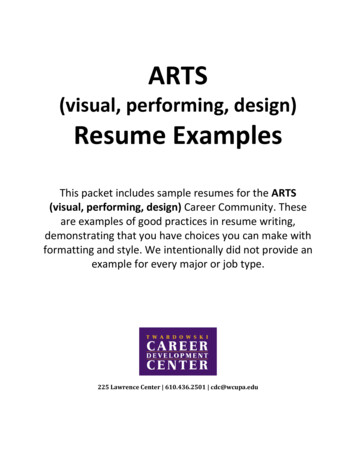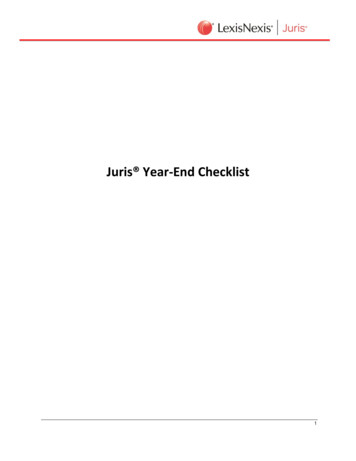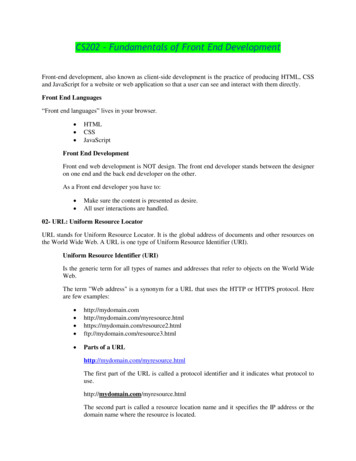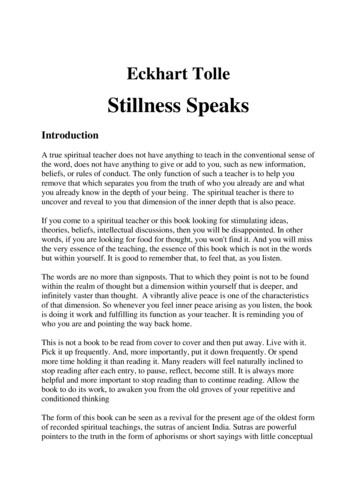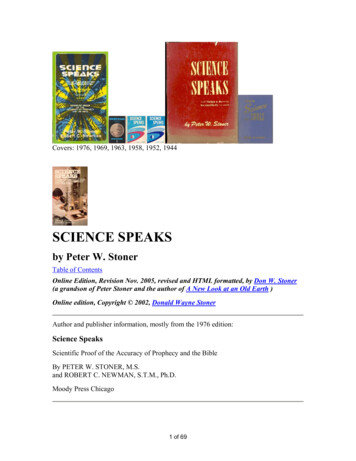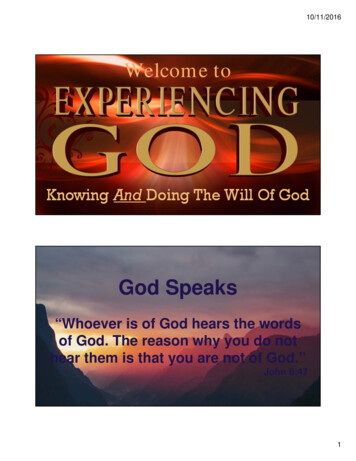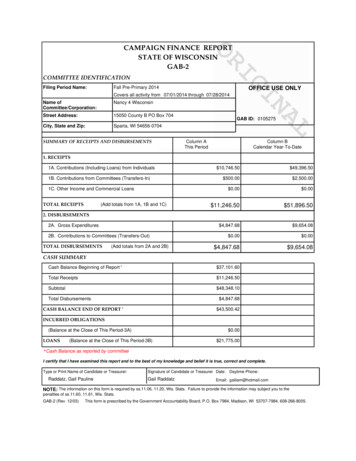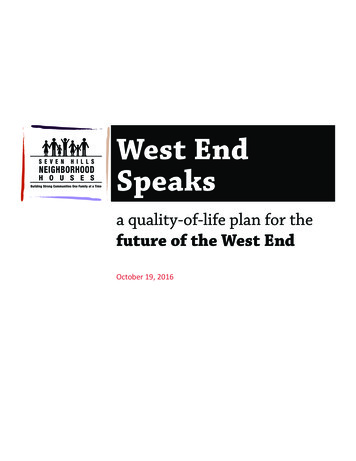
Transcription
West EndSpeaksa quality-of-life plan for thefuture of the West EndOctober 19, 2016
Table of uction to the West End CommunityProcess HighlightsLeadership and PartnersThemesOverall Goals5678910RecommendationsBusiness RecommendationsClean RecommendationsCommunity RecommendationsEmployment RecommendationsHousing RecommendationsSafety RecommendationsYouth and Education RecommendationsFuture Land Use Map111215172022252730Appendix33
AcknowledgmentsThe West End Speaks Plan was led by community members andreflects hundreds of volunteer hours committed to developing theplan.A special thank you goes out to the following leaders in thecommunity that helped make the West End Speaks Plan a reality:Work Team Co-Chairs and Community LeadersBusinessAlicia TownsendGloria ColemanCleanMildred GodfreyMelinda Butsch KovacicCommunityPaula ShermanRev. Jeaninne WalkerEmploymentRobert Killins, Jr.Kim DavisKim Hale-McCartyVonnie TawwabKeith BlakePastor Jim StrayhornMonica KeenonRichara RichardsonElla LackeyJackie MitchellFannie ShawVida ManuelTom ScharsteinJohn SpencerHousingSafetyYouth and EducationCurtis MaplesWork Team Staff and ExpertsLiz Blume, CBIAlexis Kidd, Seven Hills Neighborhood HousesLisa Carson, LISCSheila Nared, Seven Hills Neighborhood HousesAndria Carter, City of CincinnatiKathy Schwab, LISCValerie Daley, CBIAndrew Stahlke, CBIAnd a special thanks to Alicia Townsend from U.S. Bank and Robert Killins, Jr.from The Greater Cincinnati Foundation for their leadership, energy, and commitment to the West End,demonstrated throughout the West End Speaks planning process.West End Speaks PlanOctober 19, 2016 Page 3
Greetings from the Executive Director –It has truly been a pleasure to embark on the development of the West Ends Speaks Plan for the West EndCommunity in Cincinnati. This process and plan has been the collaborative work of dedicated residents,community leaders, organizations, business owners, institutions, and West End Community Council members.With this level of engagement and excitement, led by the residents and stakeholders, we believe the West Endhas a clear path which will lead to a bright future for the entire West End Community.The journey has included months of conversations, surveys, and planning meetings. The West End Speaks Planincludes 7 themes: Business, Clean, Community, Employment, Housing, Safety, and Youth and Education. Eachtheme has one or more goals and the strategies needed to accomplish these goals.We are grateful to the partnering organizations, businesses, and institutions that hosted conversations,attended meetings, and took leadership roles in the process. These hosts have included the West EndCommunity Council, Taft High School, the West End Public Library, St. Marks, West End Faith Alliance,Community Land Co-op, the Carl H. Lindner YMCA, Hays-Porter School, and Artonomy. We also thank theCommunity Building Institute, under the leadership of Elizabeth Blume and Valerie Daley, for their assistance infacilitating the WE Speaks conversations and sessions. We also would like to recognize U.S. Bank, The GreaterCincinnati Foundation, LISC of Greater Cincinnati and Northern Kentucky, and PNC for their financial support ofthe planning process.Our community is truly unifying to make the West End an even better place.The West End has often been overlooked, passed by, and totally forgotten, but it is one of Cincinnati’s best keptsecrets that is ready to be told. We are home to CityLink Center, one of the most innovative service agencies inthe region. Hope lives in St. Vincent de Paul as it looks to increase its magnitude of service to the West End andbeyond by including gardening to grow and distribute fresh produce. Q-Kidz (the best dance team in the City)has opened up their studio and starred in ‘The Fits,’ a movie shot in Lincoln Center and featured at the 2015Sundance Film Festival. Hays-Porter School will be the first high-tech elementary school in the state of Ohio.Businesses like Wegman Company, Nehemiah Manufacturing, and the National Flag Company continue to seethe value and benefits of being located in the West End Community. Seven Hills Neighborhood Houses andthe Carl H. Lindner YMCA collaborated and received one of the five inaugural Cincy Engage Challenge Grantsawarded by the City of Cincinnati in 2016.These are just a few of the great things happening in our Community and we look forward to sharing the futuresuccesses that are yet to come. Our future is bright and we are excited to see this plan in action.Moving forward,Alexis KiddExecutive DirectorSeven Hills Neighborhood Houses
Background
Introduction to theWest End CommunityThe West End is the historic heart of the African American community in Cincinnati. It was the only placeAfrican Americans could live in the early days of Cincinnati, and so what grew up as the West End was avibrant, boisterous, successful, diverse community where residents owned businesses, made music and art,fought for civil rights and raised their families. Just west of downtown, the West End was home to the statelymansions of Dayton Street, hundreds of row houses on John, Winchell, and Court streets, and the busyindustries that were fueling the Cincinnati economy. Highway construction ravaged this neighborhood in the1950s and 1960s: the construction of I-75 eliminated over 1,000 housing units and structures and displacedbetween 20,000 and 30,000 residents, mostly African American (source: http://citybeat.com/cincinnati/article33474-that which divides us.html?src longreads).The West End is also home to some of the oldest public housing in the country. A portion of the originalLaurel Homes was renovated. In recent years the transformation of over 2,000 public housing units in Lincolnand Laurel Homes created the City West project, a major re-investment in public housing by The CommunityBuilders and the Department of Housing and Urban Development as part of the HOPE IV program.Over the years the West End community has experienced the same challenges faced by other coreneighborhoods —significant population loss and a decline in the vibrancy of its economy and institutions. It hasalways been a place where people from the outside, whether with good or bad intentions, have forced change.This plan is designed to be a clear picture of what the people who live in the West End in 2016 care about,what they want their community to look like, and their priorities for change.The plan recommendations that follow represent the voice of residents of the West End and the communitypartners that work and serve in the West End. It reflects the assets that exist and the skills and talents ofthe people who live here. It focuses on what can be done to improve the community from the inside, withchurches, schools, the West End Community Council, and the many other community partners that havestepped up to make a change. The Seven Hills Neighborhood Houses has been one of those communitypartners for over 50 years. It is stepping up in a big way to help facilitate and lead the changes that this planrecommends.West End Speaks PlanOctober 19, 2016 Page 6
Process HighlightsThe West End Speaks Plan process was led by communitymembers and reflects the voice of the community.Recommendations developed were based on community inputgathered over a series of months through formal and informalengagement. The following summary includes objectives for eachstep in the process:Community Kick-Off MtgSeptember 12, 2015Introduce the process and host a community conversation.Community ConversationsOctober - November 2015Residents connect in small community conversations hosted byneighborhood institutions and discuss what they value most in theWest End and what they hope for the future of the West End.Community Priorities MeetingDecember 8, 2015Share the results of community conversations and ask the WestEnd community to help set priorities.StrategiesJanuary - March 2016Community members meet to develop strategies that move theWest End in a positive direction. They also identify partners andresources that can support the work of community organizations.Community Report Out MeetingApril 4, 2016Community members present the strategies developed that movethe West End in a positive direction. Begin implementation ofstrategies.ImplementationPlan recommendations, big and small, will be implemented bycommunity residents and partners.West End Speaks PlanOctober 19, 2016 Page 7
Leadership andPartnersWork TeamsAny resident or partner interested in making the West End aneven better place to live and do work was invited to join a WorkTeam. Work Teams were led by co-chairs, usually residents of theWest End.Work Teams developed the strategy recommendations for theWest End Speaks Plan. They were led by residents and includedresidents and partners that care about one of seven themes:Business, Clean, Community, Employment, Housing, Safety,and Youth and Education. Each of the seven Work Team firstdeveloped overall Goals, encompassing community feedback andrepresenting where residents see their community in the future.Along with each Goal, the Work Teams also proposed actionssteps to achieve those goals. Finally, they identified partners andresources that can support the work of community organizationstowards achieving the recommendations.Role of Work Team Co-chairs: Facilitate Work Teammeetings Maintain communicationwith Work Team members Prepare Goals Worksheetand Strategy WorksheetRole of Staff: Make sure process is on track Help connect with partners,resources Help connect Work Teamwith other Work TeamsStrategy recommendations that the Work Teams developedwere presented to the community for feedback at a communitymeeting in April 2016.PartnersWest End partners stepped up in a big way to make this planpossible.Local businesses and non-profit agencies met during the planprocess to network with one another and to discuss how theywere interested in playing a larger role in increasing the vitalityof the West End. They also met with Work Teams to help developstrategies.Schools, the West End Community Council, churches, andresident groups played leadership roles in the Plan process.They participated as co-chairs and participated in WorkTeams, constantly engaged the community in developingrecommendations, and drove attendance at meetings and keptpeople coming back to have their voices heard.West End Speaks PlanOctober 19, 2016 Page 8
ThemesThe West End has developed a plan for the community, by thecommunity. The plan was led by Seven Hills NeighborhoodHouses in collaboration with community organizations andleaders. The Community Building Institute helped facilitate theplanning process.The development of a neighborhood quality-of-life planis an important step to getting the community engagedand providing a community-based framework that can beimplemented. The community vision is like a roadmap tobecoming a healthier, safer and economically strongerneighborhood. It will help both public and private sectorresources and funders to see that the West End has a plan thatwas created through a broad community planning process,with a community vision that speaks to the entire community!It can be a powerful tool.Plan ThemesThese themes, as identified by thecommunity, are the top priorities forthe West outh and EducationMore specific topics under eachtheme were also set by thecommunity, and provided the basisfor final Plan recommendations.Early Topics can be found in theAppendix.West End Speaks PlanOctober 19, 2016 Page 9
Overall GoalsThe West End Speaks Plan includes 18 goals across the seven themes. The goals, along with action steps andpartners, were developed in Work Teams led by the community and presented and vetted at the CommunityReport Out Meeting in April 2016. Detailed recommendations, including action steps for each goal andpotential partners, is included in the Recommendations section of the Plan.BusinessCommunity (cont.)Goal #1: The West End has asustainable business retentionand recruitment strategicplan for recruiting andsupporting businesses that thecommunity needs.Goal #7: There are communityled, regular, sustainableevents that bring the entireneighborhood together.Goal #2: The West EndBusiness Association bringsconnectivity and a unifiedvoice to business owners inthe West End.Goal #3: West End residentshave the opportunity toown and operate their ownbusinesses in the West End.Goal #4: The West EndBusiness District is invitingand open, and has thrivingbusinesses that meet theneeds of the community.CleanGoal #5: Keep it clean, andkeep it going.CommunityGoal #6: The West End hasa communication system inplace to reach all residents inthe neighborhood.West End Speaks PlanGoal #8: There are a variety ofarts, culture, and agricultureactivities and groups in theWest End for everyone.EmploymentGoal #9: The West Endcommunity knows what jobsare available in the West End,and knows the requirementsneeded to pursue them.Goal #10: West End residentsare supported in overcomingbarriers to finding and keepingemployment.HousingGoal #11: The West Endbuilds upon its rich historyand is recognized as a greatcommunity in which to live,work, and play.Goal #12: The condition ofall West End properties isimproved.Housing (cont.)Goal #13: The quality ofaffordable units in the WestEnd is upgraded.Goal #14: The West Endsupports the expansionof homeownership in theneighborhood.SafetyGoal #15: The West End is oneof the safest communities inCincinnati.Youth and EducationGoal #16: All children in theWest End have access to allthey need to improve theiracademic performance andexcel in school.Goal #17: Children and theirfamilies in the West Endhave access to resources thathelp them be healthy, happychildren.Goal #18: The West End hasthe kind of parent and familysupport network that helpsparents be the best for theirchildren and themselves.October 19, 2016 Page 10
RecommendationsThis section includes detailed recommendations for the 18 Goals presented on theprevious page, including action steps for each Goal and partners. These recommendationsall fall within one of the following seven Plan themes:BusinessEmploymentSafetyCleanHousingYouth and EducationCommunityGoal TimelinesSHORT-TERM, accomplished within 1-3 YEARSMID-TERM, accomplished within 3-5 YEARSLONG-TERM, accomplished within 5-10 YEARSEach Goal on the following pages includes one of threesuggested timeframes (shown at left). These can beconsidered rough estimates or guidelines based onthe scope of each Goal. Some action steps within eachGoal, however, may be completed much more quickly,and some Goal timeframes may speed up as communityenergy builds around them.Future Land UseThis section also includes a Future Land Use Map thatrecommends future land uses and identifies the neighborhoodcenter of activity. This map and its land use descriptionsshould inform future zoning changes and any changes to thecommunity’s business district.
BusinessRecommendationsGoalsMID-TERM, accomplished within 3-5 YEARSGoal #1:The West End has a sustainable businessretention and recruitment strategic planfor recruiting and supporting businessesthat the community needs.The plan would include recruitment strategies, recommendationsfor space use, and the types of businesses needed in thecommunity.Action Steps1. Identify a consultant to work with the Seven HillsNeighborhood House to complete a market/development plan for recruiting and supportingbusinesses that the community needs2. Determine cost associated with the development ofthe plan - expect to spend 2,500 - 25,0003. Identify funding sourcesPartnersWest End Community CouncilSmall business owners operatingin the West EndLocal Businesses:ArtonomyNational Flag Co.Nehemiah ManufacturingTri-State BeefSeamless PrintingOther organizations operating inthe communityCity of Cincinnati EconomicDevelopment DepartmentCity of Cincinnati PlanningDepartmentCincinnati Metropolitan HousingAuthority (CMHA)The Community Builders (TCB)4. Form an Ad Hoc Business Committee to work withConsultant and CDC to ensure plan gets completedWest End Resident Associations– City West, Betts Longworth5. Ad Hoc Business Committee with CDC will developRFP for the scope of work to be completedMORTARWest End Speaks PlanAttorneyOctober 19, 2016 Page 12
SHORT-TERM, accomplished within 1-3 YEARSGoal #2:The West End Business Associationbrings connectivity and a unified voiceto business owners in the West End.Action Steps1. Understand what is required to establish a businessassociation2. Meet with other business association/allianceleaders3. Gather templates of formation/sample bylaws4. Define a mission and vision statement for thebusiness association5. Ongoing connectivity meetings take placethroughout the processMID-TERM, accomplished within 3-5 YEARSGoal #3:West End residents have the opportunityto own and operate their ownbusinesses in the West End.This includes expanding opportunities for businesses owned byAfrican-American residents of the West End.Action Steps1. Connect with the right partner to do – smallbusiness/entrepreneurial service provider2. Conduct vocal sessions – led by MORTAR to getmore input from potential participants of smallbusiness classes/workshops3. Develop marketing campaign/neighborhoodactivation strategy for businesses (coordinate withbranding initiative led by the Housing Work Team)4. Identify and secure space to deliver training5. Identify space for “pop-up shop,”6. Develop operations budget detailing start up andongoing cost to implement small business residentprogramWest End Speaks PlanOctober 19, 2016 Page 13
LONG-TERM, accomplished within 5-10 YEARSGoal #4:The West End Business District is invitingand open, and has thriving businessesthat meet the needs of the community.This includes revitalizing the West End Business District to ensureits boundaries are those agreed upon by the businesses andresidents that reside in the West End. The Business District shouldbe developed in such a way as to attract businesses and consumersto the West End.Action Steps1. Create an inventory tool – that includes thefollowing: Existing WE businessesExisting Queensgate businessesIdentify type of businessIdentify business ownerContact information for the businessBusiness size based on # of employeesExplanation of what each business doesInclude where possible – home-basedbusinesses Other organizations operating in thecommunity2. Connect business owners to other business owners(community related) on a regular basis to createbusiness community – also ties to the creation of aWE Business AssociationWest End Speaks PlanOctober 19, 2016 Page 14
CleanRecommendationsGoalsSHORT-TERM, accomplished within 1-3 YEARSGoal #5:Keep it clean, and keep it going.This includes finding ways for residents and visitors to theneighborhood to take care of their trash and not litter, and also tobring the community together for cleanups and to take care of theneighborhood.Action Steps1. Plan and share news of clean-ups and make themmore fun for community members (residents,businesses, organizations, etc.) by pairing cleanup activities with parties, cook-outs, prizes, andgiveaways and other incentives that encouragepeople to want to participate in clean-upsPartnersAll ResidentsWest End StakeholdersWest End Community CouncilNon-profit organizationsLocal schoolsBusinessesKeep Cincinnati BeautifulCommunity ToolBankYouth service programsArtistsSeven Hills NeighborhoodHouses Publicize events inside the neighborhood Connect clean-up events with Engage Cincyactivities Conduct resident interviews to show theirvalue and take photos Work with local artists2. Work with Keep Cincinnati Beautiful and otherpartners to identify ways that they can help supportcommunity cleanups and promote recycling3. Start a community-wide Adopt-A-Spot campaignin partnership with West End businesses andencourage all community partners and groups ofresidents to participate and adopt their own spot(with the goal of having the most Adopt-a-Spots inthe City)West End Speaks PlanOctober 19, 2016 Page 15
4. Create “clean street teams” and encourageresidents to report violations using the City ofCincinnati mobile app (Fix it Cincy!) and get themaddressed by the City or the property owner. Residents can report issues like litter, tallgrass, building maintenance issues andothers property and building conditions tothe City of Cincinnati. Issues are more likelyto be addressed if they are reported.5. Explore ways to increase accountability of residents(like enforcing laws and fines)6. Take back small community spaces by makingsmall improvements that increase the active use ofthose spaces (long term: add space amenities likegardens, benches, art and play structures such asslides where children could play)7. Work with schools and youth programs in the WestEnd to involve youth in keeping the neighborhoodclean and provide them education on the healtheffects of litter and pollution, on how they can makechanges, reduce littering, encourage recycling andprovide them with simple how-to’s (like using theCity of Cincinnati mobile app (Fix it Cincy!) to reportissues, and then see them resolved)West End Speaks PlanOctober 19, 2016 Page 16
CommunityRecommendationsGoalsPartnersSHORT-TERM, accomplished within 1-3 YEARSGoal #6:The West End has a communicationsystem in place to reach all residents inthe neighborhood.This includes finding ways for residents and visitors to theneighborhood to take care of their trash and not litter, and also tobring the community together for cleanups and to take care of theneighborhood.Seven Hills NeighborhoodHousesNeighborhood youthNeighborhood churchesLocal schoolsWest End Community CouncilLocal businessesOneTouchPointRobin ImagingAction StepsWest End Faith Alliance1. Form a Communications TeamU.S. Post Office Develop a consistent message to unify allforms of communication Build a resident contact list Start to communicate using a variety ofmedia formats, both online and offline Create a regular newsletter for residents2. Build relationships with other West Endorganizations and groupsNehemiah ManufacturingCompany Create an organization contact list, includingchurches, non-profits, large employers,councils and resident associations3. Connect with other W.E. Speak Work TeamsLincoln Recreation Center Find ways that the Community team canhelp other teams achieve their goals, andhow other teams can help the Communityteam reach its goalsThe WIZKaiser FoodsWegman CompanyCincinnati Public Radio andTelevisionCarl H. Lindner YMCAAvondale Youth CouncilFood Truck AssociationSt. Vincent de PaulPublic AlliesMuseum CenterBoys and Girls ClubCincinnati Police and FireDepartmentsCincinnati Human RelationsCommissionWest End Speaks PlanOctober 19, 2016 Page 17
SHORT-TERM, accomplished within 1-3 YEARSGoal #7:There are community-led, regular,sustainable events that bring the entireneighborhood together.Action StepsPartners (continued)Tailored MadeUrban LeagueCute KidsBi-Okoto Dance Co.Elementz1. Organize a volunteer corpsCincinnati Ballet Build a core leadership team to plan andcoordinate2. Survey residents on what events they are interestedinCincinnati Opera Distribute survey online and offline,incorporated with newsletter Get feedback on what interests residents3. Host events that bring the community together Consider friendly competition (such asbasketball), interactivity, a carnival/festivalor block party, a jazz/blues concert, movienight, poetry night Use event to reach people, buildrelationships, and build a neighborhoodcontact list Incentivize attendance by giving outtokens at other groups or for volunteering,redeemable at future eventExhale Dance TribeNouveau Chamber Playersconcert:novaCincinnati Contemporary JazzOrchestraCincy BrassOhio Valley Jazz BandSchool for Creative andPerforming ArtsCincinnati Symphony OrchestraArt Academy of CincinnatiMID-TERM, accomplished within 3-5 YEARSGoal #8:There are a variety of arts, culture, andagriculture activities and groups in theWest End for everyone.This means that everyone, from children to seniors, hasopportunities to gather together in existing or new places in theWest End to learn and grow.Action Steps1. Determine what people in the neighborhood arepassionate aboutWest End Speaks PlanOctober 19, 2016 Page 18
2. Connect people to art, music, drama, urbangardening, and cultural exploration Invite in professional performers, troupes,and clubs Organize field trips for youth Use regular event series to grow differentinterests (e.g. athletics, music, drama,agriculture)3. Encourage activities and interests that lead tomentor relationships and learning opportunities(e.g. etiquette and life skills)West End Speaks PlanOctober 19, 2016 Page 19
EmploymentRecommendationsGoalsPartnersSHORT-TERM, accomplished within 1-3 YEARSGoal #9:The West End community knows whatjobs are available in the West End, andknows the requirements needed topursue them.This includes identifying and developing relationships withbusinesses in the West End so that the community can understandbusiness expectations and policies for hiring and recruitment.Action Steps1. Build relationships with West End businesses Inventory businesses in the West End Go door-to-door Create a pipeline connecting communitymembers and businesses Monthly newsletter2. Create West End Work Coalition Facebook page and Monthly newsletterComputer lab and job hot lineVan and temp serviceDetermine costs and prioritize based oncommunity needs3. Hold job fairs and workshopsWest End Speaks PlanWest End Community CouncilCity of Cincinnati PlanningDepartmentWest End businessesSeven Hills NeighborhoodHousesLocal schoolsNeighborhood churchesJudgesCincinnati WorksRecreation CentersJob CorpCincinnati Metropolitan HousingAgency (CMHA)Other successful WestEnd employment-relatedorganizationsUniversity of Cincinnati andother collegesUnited WayCityLink CenterOctober 19, 2016 Page 20
MID-TERM, accomplished within 3-5 YEARSGoal #10:West End residents are supported inovercoming barriers to finding andkeeping employment.This might include supports like connecting residents withinternships, men’s support groups, or child care to address thebarriers faced by residents, especially returning citizens and youth.Action Steps1. Create mentorship and support system for residents Individuals who have overcome barriersshare West End Work Coalition to help attackbarriers2. Hold workshops to build skills, self-esteem andwork ethic Resume building CPR training Cooking classes Communication skills Sewing and art classes3. Hold community events (cook-outs, block parties,etc.) to engage with residentsWest End Speaks PlanOctober 19, 2016 Page 21
HousingRecommendationsGoalsMID-TERM, accomplished within 3-5 YEARSGoal #11:The West End builds upon its rich historyand is recognized as a great communityin which to live, work, and play.Great architecture, people, history, impact of I-75; when built,Laurel Homes was the place to live. We need to tell our story. Weneed to give people a reason to come to the West End to live.Center for Closing the Health Gap created a story board about theWest End.Action Steps1. Create documentary and videos to tell the story ofthe neighborhoodPartnersMuseums (Union Terminal/Taft)ArtsWaveDayton Street Historic DistrictCity of CincinnatiUniversity of Cincinnati Design,Architecture, Art, and Planning(DAAP)Land BankLocal Initiatives SupportCorporation (LISC)Cincinnati Development FundCincinnati Metropolitan HousingAuthority (CMHA)The Community Builders (TCB)2. Get story boards from Center for Closing the HealthGapResident and tenant associations3. Create events that bring people hereWest End Community Council4. Build upon the Dayton Street housing tours –spring/summer 2017Small homebuilders5. Festival along Linn Street with Creative Placemaking– goal of 2017 when more storefronts are filledHabitat for HumanityGoal #12: LONG-TERM, accomplished within 5-10 YEARSThe condition of all West End propertiesis improved.This would include strategies for how to deal with the large,structurally expensive properties to rehab and strategies to reducethe number of vacant and blighted land and buildings (new infill,parks, gardens etc.).West End Speaks PlanModel/BrickstoneDevelopers for new infillHamilton County HomeImprovement Program (HIP)Cincinnati PreservationAssociationCity of Cincinnati Department ofCommunity DevelopmentCity of Cincinnati Departmentof Buildings & Inspections andUrban ConservatorOctober 19, 2016 Page 22
Action Steps1. Become a Neighborhood Enhancement Programtargeted neighborhood (goal: 2017)2. Create a property map of ownership and use anda conditions assessment of all properties in theneighborhood3. Create a Housing strategy – expansion of thehousing team to be done after the map4. Identify developable sites for infill5. Work with developers to figure out how to getBloom and Heberle properties into condos andmarket rate housingGoal #13: LONG-TERM, accomplished within 5-10 YEARSThe quality of affordable units in theWest End is upgraded.This will ensure housing options at different price points. It will alsoinclude strategies that seek to maintain safe & clean housing thatmeets the needs of the both the occupant and the community-atlarge.Action Steps1. Communicate with the Cincinnati MetropolitanHousing Authority (CMHA), The CommunityBuilders (TCB), and resident and tenant associationsregarding the community’s wants and needs as wellas current and/or future plans in the community forsubsidized or affordable units Strengthen/enforce CMHA’s Good NeighborAgreement to address issues like unrulytenants allowing non-lease members tooccupy their unit, leaving common doorsunlocked, permitting illegal activity, exteriorblig
This plan is designed to be a clear picture of what the people who live in the West End in 2016 care about, what they want their community to look like, and their priorities for change. The plan recommendations that follow represent the voice of residents of the West End and th

